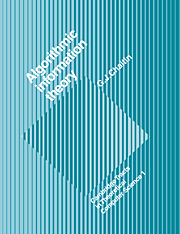Book contents
- Frontmatter
- Contents
- Foreword
- Preface
- Figures
- 1 Introduction
- I Formalisms for Computation: Register Machines, Exponential Diophantine Equations, & Pure LISP
- II Program Size, Halting Probabilities, Randomness, & Metamathematics
- 5 Conceptual Development
- 6 Program Size
- 7 Randomness
- 8 Incompleteness
- 9 Conclusion
- A Implementation Notes
- B The Number of S-expressions of Size N
- Bibliography
- Frontmatter
- Contents
- Foreword
- Preface
- Figures
- 1 Introduction
- I Formalisms for Computation: Register Machines, Exponential Diophantine Equations, & Pure LISP
- II Program Size, Halting Probabilities, Randomness, & Metamathematics
- 5 Conceptual Development
- 6 Program Size
- 7 Randomness
- 8 Incompleteness
- 9 Conclusion
- A Implementation Notes
- B The Number of S-expressions of Size N
- Bibliography
Summary
In conclusion, we see that proving whether particular exponential diophantine equations have finitely or infinitely many solutions, is absolutely intractable (Theorem D). Such questions escape the power of mathematical reasoning. This is a region in which mathematical truth has no discernible structure or pattern and appears to be completely random. These questions are completely beyond the power of human reasoning. Mathematics cannot deal with them.
Nonlinear dynamics [FORD (1983) and JENSEN (1987)] and quantum mechanics have shown that there is randomness in nature. I believe that we have demonstrated in this book that randomness is already present in pure mathematics, in fact, even in rather elementary branches of number theory. This doesn't mean that the universe and mathematics are lawless, it means that sometimes laws of a different kind apply: statistical laws.
More generally, this tends to support what TYMOCZKO (1986) has called a “quasi-empirical” approach to the foundations of mathematics. To quote from CHAITIN (1982b), where I have argued this case at length, “Perhaps number theory should be pursued more openly in the spirit of experimental science!” To prove more, one must sometimes assume more.
I would like to end with a few speculations on the deep problem of the origin of biological complexity, the question of why living organisms are so complicated, and in what sense we can understand them. I.e., how do biological “laws” compare with the laws of physics?
We have seen that Ω is about as random, patternless, unpredictable and incomprehensible as possible; the pattern of its bit sequence defies understanding.
- Type
- Chapter
- Information
- Algorithmic Information Theory , pp. 163 - 164Publisher: Cambridge University PressPrint publication year: 1987



